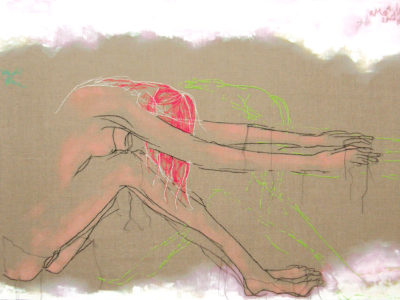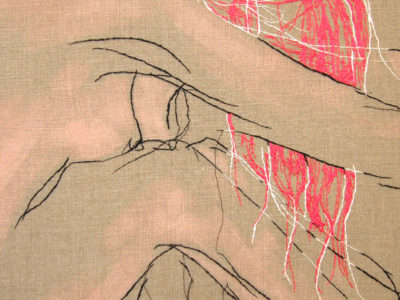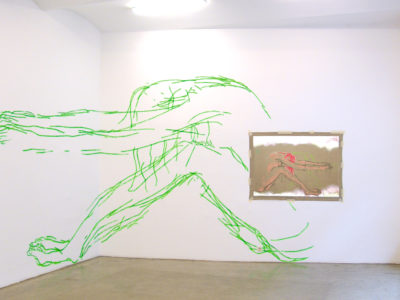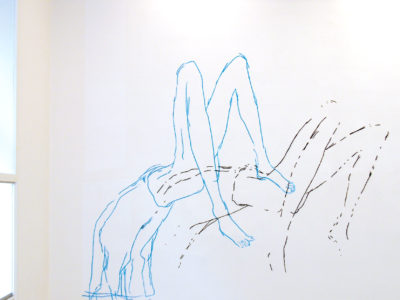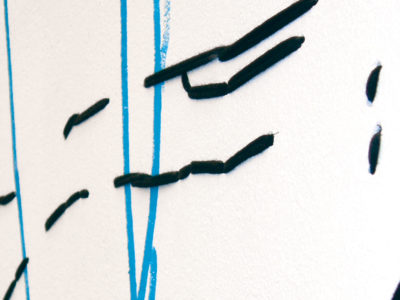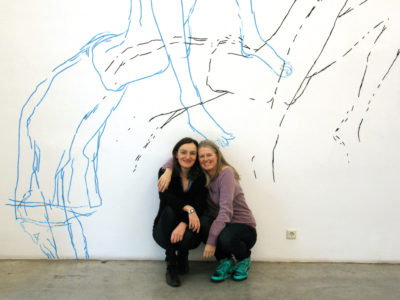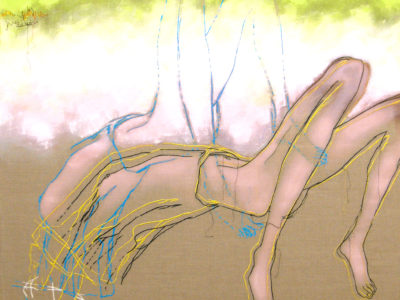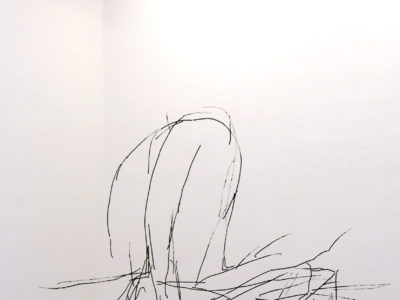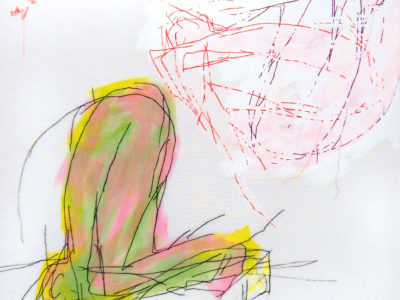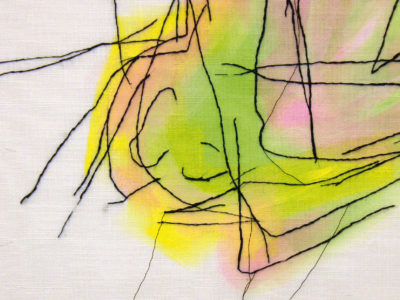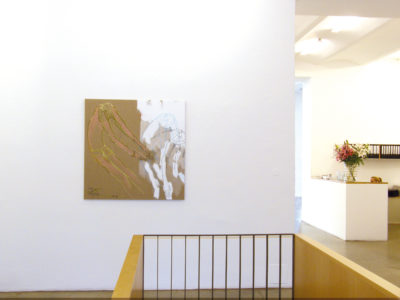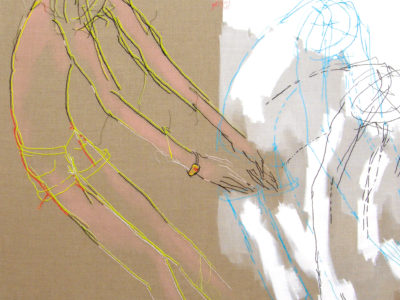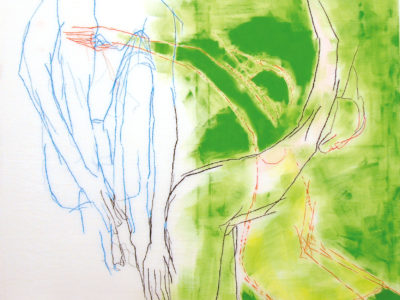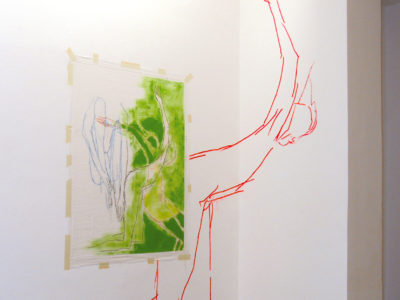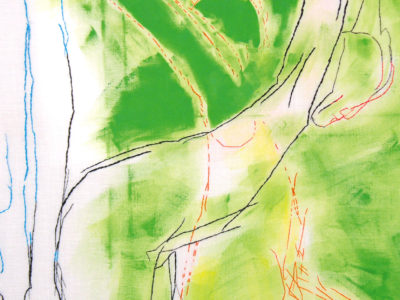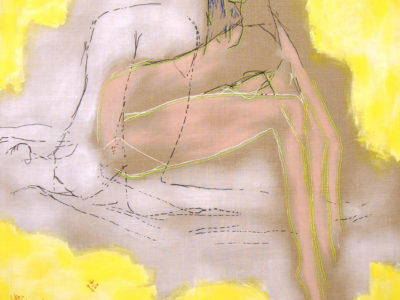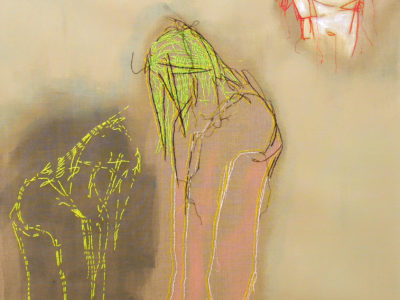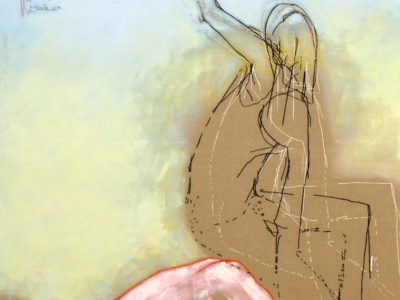Presse: „as if.“
Körperteile/Teilkörper: Fast lebensgroße Figurenumrißlinien werden auf rohe bzw. weiße Leinwände gestickt und verlieren sich manchmal in abstrakten Geflechten. Wie in einem Palimpsest legt sich die Malerei darüber, moduliert andeutungsweise die Körper, läßt Figuren in Farbräume eintauchen oder daraus hervortreten. Eine koloristische Palette, die grelle Neonfarben einsetzt, sich jedoch auf die Grundfarben und ihre Variationen reduziert, unterstreicht einerseits den expressiven Stick- und Malduktus, bezieht sich andererseits auf die Graffiti-Ästhetik: eine grelle, von Kontrasten geprägte Malweise. Ein Spiel der Widersprüche und Paradoxien wird in Gang gesetzt: Der kontemplative Modus des Stickens als Kulturtechnik, die in früheren Zeiten der sogenannten Hausfrau zugeordnet wurde, kollidiert mit einer Ästhetik des beschleunigten Handelns wie es von den Akteuren der Sprayerszene exerziert wird.
„Sgraffiare“: Kratzen auf der verletzlichen Haut der Dinge, Tätowieren des organlosen Körpers, Beschriftung der kontingenten Territorien des Unsagbaren. Und dann in einem Akt der Expansion und der Inversion: Hinausdrängen über die Bildränder, Sprengung der Formate, Liquidierung/Liquefizierung des Objektcharakters. Dieselben Figuren, nun gespiegelt, gedreht, verdoppelt, werden mit Neonfarben gestisch an die Wand gemalt, ein Figurenfragment wird mit schwarzem Leinenfaden direkt in die Wand genäht. Ein Malgrund wiederholt sich andersfarbig.
Die Ausstellung segelt unter dem Banner eines „as if.“ Als ob es möglich wäre, dass der Stickerei eine normensprengende Kraft innewohnte. Als ob die im Schutze der Nacht und der Anonymität applizierten Graffiti durch die Verlagerung in den Innenraum domestiziert werden könnten. Als ob das Ornamentale und das Abstrakte in morganatischer Verbindung einen visuellen Raum begründen würde, in dem die Tyrannei der Intimität in einen expressiven Befreiungsgestus umschlüge, und die Delinquenz der Sprayerkunst durch die kontextuelle Verschiebung eine alternative Form der sozialen Interaktion herstellte.
Die Bildwucherungen von Fulterer/Scherrer, die buchstäblich den Rahmen sprengen, sind Versuchsanordnungen in einem visuellen Labor, deren Zweck, neben der Herstellung einer verwundeten Schönheit, darin besteht, Vorschläge für eine Entgrenzung von Produktionstechniken zu unterbreiten. Als ob in der ästhetischen Festschreibung eines Gestus gleichzeitig die Möglichkeit seines unendlichen Remixes läge. Magie des Banalen, Banalität der unversöhnlichen Einschreibung an der Peripherie des gesellschaftlichen Normverhaltens. In einem bekannten Popsong heißt es: “You`ve got to pick up every stitch must be the Season of the Witch.“
Thomas Miessgang 2013
Press release: „as if.“
Body parts / parts of bodies: Outlines of almost life-size figures are embroidered onto canvas raw or white, sometimes dissolving into an abstract tangle of lines. As in a palimpsest, paint is applied over this surface, implying a certain degree of body modeling and allowing the figures to meld into color spaces or emerge from them. The palette, which makes use of bright neon colors while at the same time remaining limited to the primary colors and their variations, underlines the expressive rhythm of the embroidery and the painting, whereby it also relates to a graffiti aesthetic: an approach to painting that is flashy and full of contrasts. A game of contradictions and paradoxes begins: the contemplative mode of embroidery, in earlier times associated with the so-called housewife, collides with the aesthetic of accelerated activity characterizing the participants of the sprayer scene at work.
„Sgraffiare“: scratching at the vulnerable skin of things, tattooing the organless body, writing on the contingent territories of the unsayable. And then in an act of expansion and inversion: pressing beyond the picture’s edges, bursting out of the formats, liquidation/liquification of the object character. The same figures – now mirrored, rotated, doubled – are painted gesturally on the wall in neon colors, while a fragmentary figure is sewn directly onto the wall in black thread. A painting ground is repeated in another color.
The exhibition sails under the banner of an „as if“. As if it were possible that a norm-transcending power were inherent in embroidery. As if graffiti, applied anonymously under the sheltering curtain of night could be domesticated by bringing it indoors. As if the ornamental and the abstract, in a morganatic marriage, could establish a visual space transforming the tyranny of intimacy into a gesture of liberation, and the delinquency of sprayer art could, through contextual displacement, produce an alternative form of social interaction.
Fulterer/Scherrer’s rampantly growing images, which literally break through their frame, are experimental setups in a visual laboratory, whose purpose, beyond the creation of an injured beauty, is to offer proposals for opening the borders of production techniques. As if the aesthetic concretization of a gesture could at the same time open up the possibility of endless remixes. The magic of the banal, the banality of unconciliatory inscription on the periphery of social norms.In the words a well-known pop song: „You’ve got to pick up every stitch, must be the Season of the Witch.“
Thomas Miessgang 2013 (text on the exhibition „as if.“ at the Christine König Gallery)
